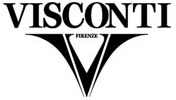
Interview
with Dante Del Vecchio founder of Visconti
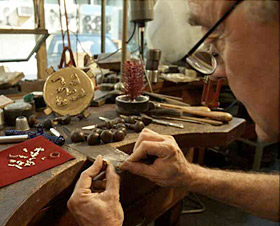 1. Why the passion
for this business? 1. Why the passion
for this business?
I’ve had a long, enjoyable
love affair with writing instruments. To me it is not a
business but a passion. It started by my owning a pen shop for
10 years, from 1977 to 1987. My family passed on to me both
the desire and the ability to start manufacturing. They were
factory owners: my grandfather being an artist in wrought iron
production. He won prizes and awards in Paris in 1928 and Rome
in 1935. To sum up: passion, art and entrepreneurship run
thick in my veins.
2. What is
the structure of Visconti?
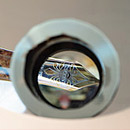 Visconti is structured to promote
excellence where creativity, innovation and organisation live
together in harmony. It is divided into departments and
professional tasks (finances, sales, invoicing, service,
production, R&D etc) all functioning as a team. The
relationships among our employees are informal: we live like a
big family or, better said, like a big melting pot of
creativity. Competition between associates is seen in a
positive way, in fact teamwork and mutual support are our
cultural heritage. Visconti is structured to promote
excellence where creativity, innovation and organisation live
together in harmony. It is divided into departments and
professional tasks (finances, sales, invoicing, service,
production, R&D etc) all functioning as a team. The
relationships among our employees are informal: we live like a
big family or, better said, like a big melting pot of
creativity. Competition between associates is seen in a
positive way, in fact teamwork and mutual support are our
cultural heritage.
3. Which
elements or situations inspire you most?
For
sure culture! All our creations are products of culture, they
may even seem to be spontaneous creations! The Visconti clip,
for instance, represents the bridge, a symbol for friendship,
of union between peoples. It’s a unifying not a dividing
element. This is the task of pens, which for centuries have
been recognised as symbols of diplomacy!
Other sources
of inspiration are contemporary history and our town, Florence
- which is a work of art in itself. It is an inextinguishable
source of inspiration. Indeed when we consider that Visconti
creates and manufactures its pens in a 13th century villa,
what more can I say?
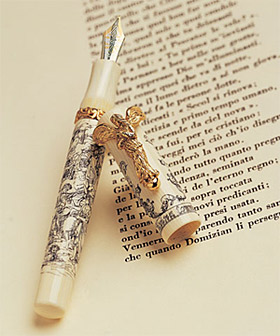 4. Is exclusivity a
symbol for Limited Editions? 4. Is exclusivity a
symbol for Limited Editions?
Not necessarily.
Owning a Visconti today, no matter which style, is a mark of
exclusivity and of a careful choice. A choice based on
creativity and on “Made in Florence”, specifically - a good
luxury, a quality luxury. I will speak again later on what I
mean by ‘good’ luxury.
A Limited Edition is not always
a good product since sometimes it is undervalued and some
limited editions do not even have the qualities to be
“valuable”. For Visconti a limited edition pen must provide
innovation, creativity, art and be produced in quantities
below the demand of the potential market. In fact, Visconti
limited editions of a few years ago have been completely sold
out!
5. Can you reflect on
technological innovation in the luxury pen
market?
A pen is a traditional object that lived
through two golden ages in its history - from 1920 to 1950 and
from 1990 to 2000. Technological innovation in the last 40
years has been almost non-existent.
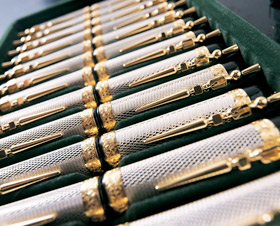 At Visconti we can clearly define two
periods of change as related to the luxury pen market. The
beginning, with the rediscovery and the idea to use
“forgotten” or historical pen materials such as Celluloid or
Ebonite. This made our entry into the market possible,
distinguishing our brand from the others using mass market
materials (like injected plastic). At Visconti we can clearly define two
periods of change as related to the luxury pen market. The
beginning, with the rediscovery and the idea to use
“forgotten” or historical pen materials such as Celluloid or
Ebonite. This made our entry into the market possible,
distinguishing our brand from the others using mass market
materials (like injected plastic).
The second phase
when Visconti, as only brand in the world, started to
innovate and register patents (more than a dozen, three in the
last two years). The most significant patents were made to
restyle pens: solution for ink losses in airplanes, cap
fitting, filling system, and the traveller
inkwell.
6. Which features are
compulsory in a pen?
Elegance! And it is not so
easy to define it, since it is a combination of different
factors, like proportions, colours, form, handiness and
weight. A good pen must have all of this and if a small detail
fails, you’ve failed.
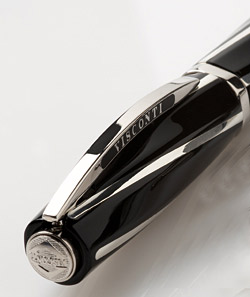 7. Which creation
made you most proud? 7. Which creation
made you most proud?
In Italy we say: every
cockroach is pretty for his own mother! But if I have to make
a choice: the “Divina Proporzione” without any doubt. It is a
pen with all qualities in harmony, the word “perfect” is
inadequate to its description.... “Divine” is absolutely the
right word!
8. How do you
chose the names for your collections?
Visconti
creates two types of pens: the “Regular Editions” and the
“Limited Editions”.
For the first ones the name must be
easy to be pronounced in all languages, it must communicate
the message of the collection and must be well known to the
widest public.
For the L.E. indeed it’s sufficient for
the name to represent the emotion that we want to communicate,
in fact a Visconti Limited Edition is first of all, an
emotion.
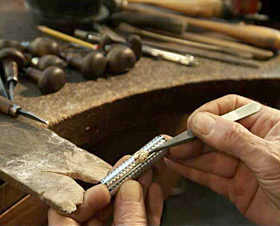 9. Who is the target
of your creations? 9. Who is the target
of your creations?
People that can appreciate
them! I always say that if you see a pen of ours and you feel
an emotion... then it means that we did a good job. Our
creations must gratify our hearts and brains, they must make
people feel a deep emotion, like in those moments when you’re
in front of a Picasso or a De Chirico that you’ll never be
able to own. The wonderful part is, in the case of our ‘art’
you can indeed own it... that’s even
better!
10. Which occasion
is best to give a pen as a present? How do you chose the right
model for a person?
There is no “best occasion”
as a pen is so easy to give as a present. It is made for all
occasions, even the most difficult ones. For birthdays,
ceremonies, business presents etc., pens are always
appropriate and welcome.
A pen makes an excellent gift
for a man, as it is one of the few masculine accessories which
are appropriate for all occasions. Today’s woman also
appreciates true luxury! With a carefully handcrafted
masterpiece as the choice, you can’t go wrong.
The only
problem is there is no “way” to make an easy choice. It is all
a question of taste: maybe you select it as an expression of
your personality or maybe the personality of the future owner.
That’s so much of the fun. There is one little problem with
purchasing a beautiful pen as a gift. We often see customers
purchase both a pen as a gift and at the same time, purchase a
pen as a gift for themselves!
11. How do you choose the locations for your
stores?
The locations must be consistent with
and supportive of the brand image. The materials, the
craftsmanship and the exquisite designs deserve to be
presented in a manner true to their origins.
12. In the world of craftsmanship there is the
“Made in Italy” mark. What is your view on the this as it
applies to Visconti?
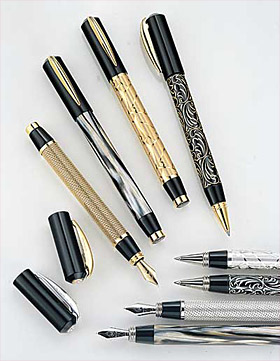
Visconti has abandoned the “Made in
Italy” attribution in deference to “Made in Florence”.
Visconti produces its pens entirely in the most beautiful town
in Italy and we want to ensure our patrons understand and
appreciate this element of their creation. Indeed Florence is
part of our brand - the word “Renaissance” central to Florence
is also central to Visconti. While this element is of great
importance for us it is also very important to our clientele
encouraging us to export Visconti craftsmanship to over 40
countries.
13. Can you define
your view
of luxury for us?
In my view there
are two types of luxury: the hedonistic one, which is usually
identified with the brand and its association with the
purchaser, and another one, a sort of “good” luxury. The
‘good’ luxury is based in truth; on the value of the elements
in the creation and how the creation respects those elements.
At Visconti we believe in a product that is very close to a
work of art, one that will not be mistaken for ‘mass
production’.
The price for our creations reflects the
care, the time, the craftsmanship, the flawless materials and
the creativity inherent in each creation. The price of the pen
is not the value of the pen. The one who appreciates the pen
they own, places the value on it.
Some of our clients
seek a timeless work of art, a luxury that is not based on
ephemeral elements but on creativity, materials, innovation,
passion.
We work hard to make Visconti pens. Those who
own them have worked hard to be in a position to enjoy the
kind of luxury captured and delivered in every Visconti
creation. Our workmanship pays homage to their efforts to
achieve and their selection of Visconti reflects on our
efforts to provide them with a declaration of their
achievement. The union, like the bridge on our pen, is a
perfect one.
|
Key Dates
in Visconti’s History
1988 The market
for writing instruments was stagnant: most of the existing
companies produced repetitive, predictable, even boring pens,
with models lacking in innovation and style. Suffice it to say
a pen catalogue would have consisted of very few pages. Most
pens are black and some had golden caps. However, there was a
glimmer of hope: in 1988, in the United States, Pen World
magazine was born, while in Florence, Visconti was founded.
The main goal of Visconti was to launch a beautiful vintage
pen, like those of our grandfathers, turned by hand on a lathe
from pure celluloid blocks. Thus Visconti sowed the seeds of
luxury and collecting in the pen industry.
1988/1989 Visconti launched their first
celluloid collection. ‘Classic’ comes in six marble-like
colors triggering real shock, surprise and delight in the
market: Visconti is on every pen aficionado’s
lips.
1989 The young
company doesn’t settle for the success it has obtained in such
a short time. Visconti found a Japanese craftsman producing an
old 1920 pen in Urushi lacquer, totally by hand. Furthermore
the craftsman handmade the nibs himself. Visconti obtained the
exclusive rights. The Urushi pen became the first limited
edition of our day and the first 50 pieces were soon sold out.
Visconti made the first page of the newborn magazine ‘Penne’.
1990 The success of
the Urushi pen (three years of pre-scheduled sales) leads the
way. The Visconti collection was enriched by a 14 color line
of vintage celluloid pens, in limited edition. Visconti
located special material stock which they turned into its
first piston model pen with a solid gold nib: D’Essai. The
collection was sold in a pen case made of Florentine
briarwood. When auctioned the rare and exciting pieces
skyrocketed just like newborn Swatch watches. In the two years
since its beginning Visconti has revolutionized the pen
market.
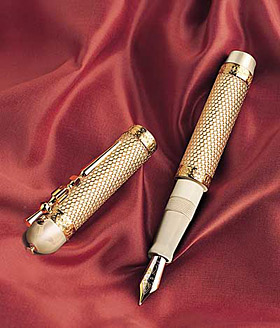 1991 In the
first three years Visconti concentrated mostly on materials
rather than on the design of its pens. With Ragtime, while
maintaining a classic pen setting, Visconti introduced its
first personal touch in pen design; maybe not mature and well
developed enough, but certainly innovative. 1991 In the
first three years Visconti concentrated mostly on materials
rather than on the design of its pens. With Ragtime, while
maintaining a classic pen setting, Visconti introduced its
first personal touch in pen design; maybe not mature and well
developed enough, but certainly innovative.
Ragtime was
launched at an extraordinary event in Piazza Signoria in
Florence, inside Banca Nazionale Dell’Agricoltura’s
headquarters to an overflow crowd of 170 people. No similar
events occurred in 1991 for the launch of a fountain
pen.
1992 The Year Of
Columbus’ anniversary marked the birth of another limited
edition: Caravel. It introduced the concept pen: a pen, an
inkpot, a wallet and ink tabs commemorating Columbus’ sea
journey. A Florentine painter, Mario Fantini, completed the
concept painting in three months - 1500 lacquer paintings
which became part of the pen cases.
1993 The year is remembered for the
launch of the depression filling system, still used today on
many Visconti models: High Vacuum Power Filler. Two
extraordinary new pens are endowed with this system: Voyager
and Uffizi. The clip represents a sailing boat that plunges
into a wave; the clip was designed by Visconti the year before
for The Moro of Venice sailing team. Unfortunately they did
not win America’s Cup. After this however Mr. Raul Gardini
graciously authorized Visconti to use the design on Visconti
pen clips.
1994-1996 During
this period Visconti invested heavily in materials research:
the growing company walked away from celluloid after five
years. At the same time all of their competitors were just
discovering it. For other pen manufacturers celluloid was a
novelty, but Visconti had already been producing over 10.000
pieces of celluloid pens each year. It was obvious that
alternatives had to be found and Visconti was successful with:
ebonite, bakelite, ivory and resins for the basic models.
During this period we remember three absolute works of art:
Alhambra- decorated in silver or in gold with a technique
never to be used again, Taj Mahal – the first pen jewelled in
filigree, decorated with diamonds totalling 8 cts for the
Sultan of Brunei, the first collection pen without a clip, the
Leopardi – the first mini size pen vanguard of its time, with
laser-engraved on the barrel the entire poetry ‘L’Infinito’.
Most probably this was the first time a laser was used to
engrave a luxury item. In 1996 Visconti acquired the licence
FI 1425 to produce and commercialize precious
materials.
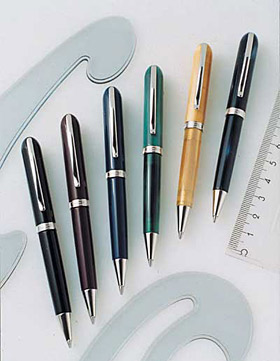 1998 The year
of the patent for the Double Reservoir that brought a
significant innovation in fountain pens was filed, freeing the
lovers of fountain pens from the nightmare of using it while
aboard a plane. This filling system represents the sole real
technological breakthrough in the industry since WWI and
identifies Visconti not only as a great pen manufacturer but
also a recognized innovator in the field. 1998 The year
of the patent for the Double Reservoir that brought a
significant innovation in fountain pens was filed, freeing the
lovers of fountain pens from the nightmare of using it while
aboard a plane. This filling system represents the sole real
technological breakthrough in the industry since WWI and
identifies Visconti not only as a great pen manufacturer but
also a recognized innovator in the field.
1998- 2001 The end of the 20th century
saw Visconti experience continuous growth. In co-operation
with German and American suppliers Visconti felt the need to
find its own identity. The collection pens or the limited
editions while being a good business, did not provide enough
to cover the investments required in machines, let alone the
funds to create brand awareness outside the circle of pen
collectors. Visconti was probably the first to realize that
collection pens do not sustain a brand. This insight and the
consequent research laid the foundation for today’s Visconti:
a modern manufacturer seeing the pen not only as a luxury item
but as an accessory, even a means of communication, for the
modern man.
2000-2003
The new Visconti identity resides in the clip and in the pen
shape. Time proved that the launch of a dedicated and
recognizable brand not only required years but also millions
of euros in advertising. In 2000 the Millennium pen was
launched: its clip was shaped like a bridge, to symbolize the
crossing from the two millennia of the past into the beginning
of the third. The clip with the name Visconti was to become
the flagship of the company: the most severe judge, vox populi
– the voice of the people-had approved it.
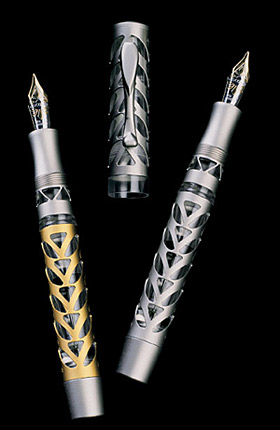 2003-2005
After the clip, although Visconti already had a top seller in
the Van Gogh line, looked for a defining shape. It was in the
study of Leonardo Da Vinci’s Vitruvian man, inscribed in the
square and in the circle, that Wall Street saw the light.
Squaring the circle was imitated on a vast scale from the
beginning. The shape blends into a unique design the stability
and balance of the square with the movement of the circle:
Visconti had found its dimension. 2003-2005
After the clip, although Visconti already had a top seller in
the Van Gogh line, looked for a defining shape. It was in the
study of Leonardo Da Vinci’s Vitruvian man, inscribed in the
square and in the circle, that Wall Street saw the light.
Squaring the circle was imitated on a vast scale from the
beginning. The shape blends into a unique design the stability
and balance of the square with the movement of the circle:
Visconti had found its dimension.
2005-2007 is recent history and
Visconti’ s masterpieces are born either accidentally or with
a good dose of luck. Everyone talks about Da Vinci’s
code and Leonardo had already triggered indirectly the
inspiration for the collection ‘Squaring the Circle’, so
little was needed in order to come up and interpret the Divina
Proporzione. The extraordinary fact is that the pen was
designed in ten minutes on a math exercise book. Four hours in
the laboratory completed the exact inclination of the golden
spiral and the related patent for the hook safe closing system
and its filling…simply genial intuitions!!
In fact with
Divina Proporzione Visconti has not only created a masterpiece
but also ‘squared’ the circle of its collections, placing at
the high level a very representative pen and completing its
range that saw Van Gogh as entry level, Squaring the Circle as
middle range and Divina at the luxury end.
Epilogue:
What else is left to be
said? After all this time the passion is as strong as it was
in the beginning. The emotion when we see a new pen is
absolutely intact, just like the first time and the best pen
is always the next one! For Visconti the pen is a means of
communicating our emotions, a canvas to paint, a movie to
shoot. Some say our pens are too difficult to understand
because they are too philosophic! Well…they are right! We are
bound by our culture and we see pens as expressions of culture
and a means to convey that culture. Much of what we put into a
pen is hidden from the eye, but revealed to the soul. You will
never find an anonymous Visconti... it is not in our DNA.
However the adventure initiated 20 years ago by two madmen
that wanted to produce pens is today a solid reality, a team
of passionate employees managed informally but professionally
by one of the two ‘madmen’. The creativity has not been
altered but united to a unrivalled know-how and to a quality
standard. Thousands of pen lovers worldwide appreciate
Visconti pens and many trust us to develop their projects. We
receive every day words of praise for our dedication and for
the work of the 50 people in Florence, encouragements to keep
up with the same passion and drive as if it were the first day
so that Visconti continue to be in your
hands.
|
|
Buy a Visconti
pen. They are all excellent writing instruments.
| |